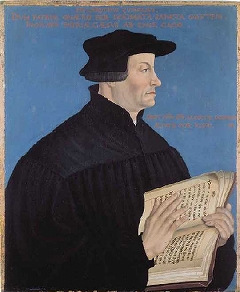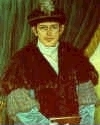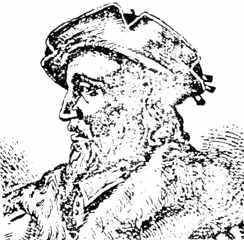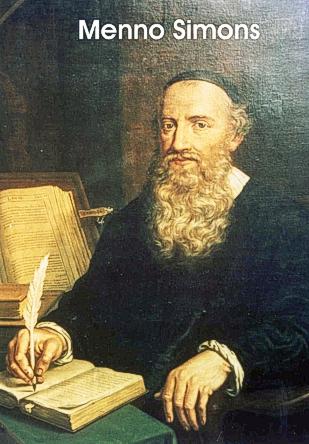Zwingli; Anabaptists
WYH2010H, Fall 2005
Links
Here's a very large map from the (in-progress) William Shepherd Historical Atlas (at the Perry-Castañeda Library, University of Texas, Austin) of the Swiss Confederation. It's very detailed but you can navigate around it.
An on-line Canadian encyclopedia of Anabaptism isn't as comprehensive as it sounds but has some valuable material.
Here's a webpage with links to many other Anabaptist resources.
- Born January, 1484, in Wildhaus, in northern Switzerland.

- Studied classics and Latin under his uncle in the nearby town of Wesen beginning at age ten, then moved on to further studies in Basel (1494), and Bern (1496). Attended university in Vienna (1498) where he was introduced to humanism, then returned to Basel to receive his BA (1504) and MA (1506). He also met and was greatly influenced by Erasmus during his time in Basel.
- Appointed parish priest in village of Glarus (1506), where in his spare time he studied Scripture, Greek, Hebrew, and the Church Fathers. During his ten years there, his political convictions and pastoral experience as a military chaplain led him to voice public opposition to the Swiss mercenary trade.
- Moved in 1516 to nearby parish in Einsiedeln, where his skilful preaching and ministry to pilgrims visiting the local shrine, as well as his clever and scholarly denunciation of a Franciscan indulgence seller in 1518, gained Zwingli some renown.
- Nominated in 1518 as people’s priest at the Grossmünster church in Zürich, a position with considerable prestige and influence. It was here that Zwingli initiated his Reform programme and served until his death in battle in 1531.
Zwingli’s Reformation
- January 1, 1519 — Zwingli began preaching through the gospel of Matthew instead of from the text in the liturgical calendar.
- Lent 1522 — Zwingli was present at the home of printer Christoph Froschauer where several in attendance broke the Lenten fast by eating sausage. Zwingli gave approval to the action.
- July 1522 — Zwingli circulated a petition asking the bishop of Constance "To Allow Priests to Marry, or at Least Wink at Their Marriages."
- July 1522 — After voicing opposition to preaching which promoted the veneration and intercession of saints, Zwingli and his circle influenced the town council to issue a decree restricting orthodox preachers to sermons which conformed to Scripture.
- January 1523 — Zwingli engaged in a public disputation in the Zürich town hall regarding these reform issues. He was declared the winner, and received the official approval of the town council. He set forth his case in a published treatise of 67 articles.
- Fal, 1523-January 1525 — Even as Zwingli’s Reformation spread through the Swiss cantons, it was subjected to internal conflict as more radical members of his camp grew dissatisfied with the pace and priority of Zwingli’s reforms. A group led by Conrad Grebel broke away, beginning a more radical Reformation movement.
- 1529 — At the request of Landgrave Philip of Hesse, Zwingli, Luther and Melanchthon from Wittenberg, Martin Bucer from Strasbourg, and Oecolampadius from Basel met for what is known as the Marburg Colloquy, in an unsuccessful attempt to try to bring theological unity to the Protestant Reformation.
Brian Cooper’s Quick and Easy Summary of the Leaders of Early Anabaptism
I. Swiss Anabaptism
Ulrich Zwingli
In the early 1520's he came to see the need for reform of church practices such as baptism, holiday observances, and the mass to bring church practice into greater conformity with Scripture. Though not an Anabaptist himself, his reforms influenced the first Anabaptists.
Conrad Grebel
 He was
the assistant to Zwingli who did not believe that Zwingli’s reforms
went far enough, especially with respect to Zwingli’s willingness
to allow the Zürich council determine the course of reform in the
Zürich church. Grebel began to dispute with Zwingli and broke with
him by performing the first believers’ baptisms in January, 1525.
Having been influenced to some extent by Karlstadt and in particular because
of their correspondence with the revolutionary leader Thomas Müntzer,
the Swiss Anabaptists were unjustly accused of being not only heretics,
but also rebels and murderers. Grebel died of the plague in 1526.
He was
the assistant to Zwingli who did not believe that Zwingli’s reforms
went far enough, especially with respect to Zwingli’s willingness
to allow the Zürich council determine the course of reform in the
Zürich church. Grebel began to dispute with Zwingli and broke with
him by performing the first believers’ baptisms in January, 1525.
Having been influenced to some extent by Karlstadt and in particular because
of their correspondence with the revolutionary leader Thomas Müntzer,
the Swiss Anabaptists were unjustly accused of being not only heretics,
but also rebels and murderers. Grebel died of the plague in 1526.
Michael Sattler
He came to Swiss Anabaptism by about March, 1525, by way of Lutheranism
and Zwinglianism. He spent some time in Strasbourg in 1526 and made contact
with sympathetic Reformers Martin Bucer and Wolfgang Capito. Although
no one knows with certainty how it came to be called or who participated,
the accepted tradition is that Sattler drafted the seven articles of what
has come to be known as the Schleitheim Confession; these articles were
discussed, rewritten, and approved during the course of the meeting. Sattler
was burned at the stake sometime shortly thereafter in 1527.
II. Moravian Anabaptism
Balthasar Hubmaier
 The priest
in Waldshut who had shown interest in Zwinglian reform for some time (he
was involved in some disputations with Zwingli and others in the early
1520's) but was ultimately baptized by the Swiss Brethren in April, 1525,
along with sixty others, by one of Grebel’s associates, William Reublin
from Zürich. A trained theologian, Hubmaier fled Waldshut and spent
some time in Zurich where he wrote several pamphlets. He eventually had
to flee to Moravia, where there was greater religious toleration. The
combination of Hubmaier’s more favourable attitude toward Christian
participation in civil government and the openness of the local authorities
contributed to Hubmaier’s initiation, first in Waldshut and then
in Nikolsburg, of the only popular Anabaptist Reformations. Eventually,
however, his protector in Moravia was forced to turn him over to authorities
who took him to Vienna, where he and his wife were tried and executed
in 1528.
The priest
in Waldshut who had shown interest in Zwinglian reform for some time (he
was involved in some disputations with Zwingli and others in the early
1520's) but was ultimately baptized by the Swiss Brethren in April, 1525,
along with sixty others, by one of Grebel’s associates, William Reublin
from Zürich. A trained theologian, Hubmaier fled Waldshut and spent
some time in Zurich where he wrote several pamphlets. He eventually had
to flee to Moravia, where there was greater religious toleration. The
combination of Hubmaier’s more favourable attitude toward Christian
participation in civil government and the openness of the local authorities
contributed to Hubmaier’s initiation, first in Waldshut and then
in Nikolsburg, of the only popular Anabaptist Reformations. Eventually,
however, his protector in Moravia was forced to turn him over to authorities
who took him to Vienna, where he and his wife were tried and executed
in 1528.
Jakob Hutter
A hat-maker, he joined an Anabaptist group in Tyrol (a province of Austria) in 1529, and moved to Moravia in 1533, to join a group which had sought refuge there. He became a leader, and his group, the Hutterites, continue today. He advocated community of goods. He was betrayed in 1535, and taken to Innsbruck, where he was tortured, and finally executed by burning in 1536. His wife Katherine was executed two years later.
III. South German/Austrian Anabaptism
Hans Denck
On his way to Moravia, Hubmaier stopped in Augsburg in southern Germany where he baptized Hans Denck, a Latin scholar who had lost his position in Nuremberg because of his sympathy for reformation radicals. Denck travelled in the area and was largely responsible for spreading Anabaptist teachings to Strasbourg. He died in Basel in 1527 suffering from the consequences of fleeing constant persecution.
Hans Hut
Hut was baptized by Denck in Strasbourg, and went on to become the foremost Anabaptist evangelist, spreading his brand of mystical apocalyptic Anabaptism. Hut had been a follower of the revolutionary Thomas Müntzer but had managed to escape capture and execution after the Peasants’ Revolt in 1525. He died in prison in 1527, but his corpse was nevertheless tried, convicted of heresy, and burned at the stake.
Pilgram Marpeck
Baptized in 1527 (after the deaths of many of the first
generation of Anabaptist leaders), he was, not merely by default, the
strongest leader among Strasbourg Anabaptists. He sought to bring unity
among the sectarian factions and intercede for Anabaptists with the Magisterial
church authorities. Like many Anabaptists, Marpeck was compelled to move
often to avoid persecution. He used his training as an engineer to obtain
civil service work in several towns. Unlike most of the other Anabaptist
leaders, he died a natural death in 1556.
IV. North German/Dutch Anabaptism
 Menno
Simons
Menno
Simons
He was the Dutch priest who heard about and was moved to reconsider his
theological convictions after hearing news of the Münster rebellion.
After being ordained an Anabaptist elder in 1536, he helped the remnant
of Melchiorite Anabaptism shed its militant apocalypticism for a quiet
sectarianism and came to be the best known leader of the movement which
now bears his name, the Mennonites.
Melchior Hofmann
A self-taught Lutheran and later Zwinglian, he came from preaching in northern Germany and Scandinavia to Strasbourg after coming into contact with Anabaptist teachings. He was forced to leave Strasbourg, whereupon he returned to his home territory and preached an apocalyptic message; he came to believe that he was the "second Elijah" who was come to announce the coming of the new Jerusalem to Strasbourg. Returning to face imprisonment (which he believed was necessary), he came to languish in prison for ten years, and died there. His followers went from being passively to violently millennial, and attempted to establish the New Jerusalem in Münster in 1534-35, but their rebellion was crushed.